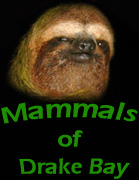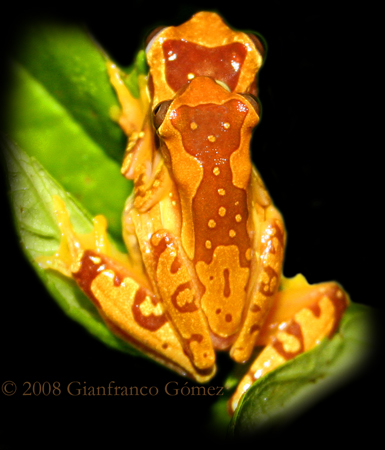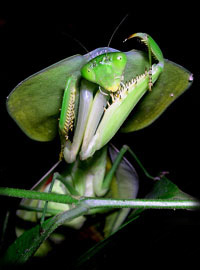|
Discover the
hidden treasures of Drake Bay, Costa Rica with Tracie "The Bug Lady" .

Home

Tour
Basics

Meet the Bug
Lady

Tales from the
Edge

Media

Reservations

Links



Facts about Drake Bay, Costa Rica

Travel To Drake Bay

Drake Bay Area Map

Hotel Information

Tips for Travelers

Tours

Recommended
Reading





|
|
|
 Hourglass
Tree Frogs are one of Costa Rica's most sought after frogs by nature
photographers. They simply make great subjects. With their blend of
coppery orange and golden yellow, these beautiful little frogs are
true jungle gems. Hourglass
Tree Frogs are one of Costa Rica's most sought after frogs by nature
photographers. They simply make great subjects. With their blend of
coppery orange and golden yellow, these beautiful little frogs are
true jungle gems.
Their common name comes from the hourglass shaped pattern which is
usually present on the frog's back, as can be seen below. The
pattern could also be described, perhaps more accurately, as the
portrait of a sitting cat. Their arms and legs are normally boldly
patterned, but their thighs are always a solid yellow color. This
explains the species name, ebraccata, which in Latin means
"without trousers". |
|
 Hourglass
Tree Frogs are small frogs, with adult females measuring 35
millimeters at their largest and adult males only 27 millimeters.
They inhabit the humid lowlands on the Caribbean and Pacific slopes
of Costa Rica and are apparently absent from the drier Guanacaste
Province in the northwest of the country. Hourglass
Tree Frogs are small frogs, with adult females measuring 35
millimeters at their largest and adult males only 27 millimeters.
They inhabit the humid lowlands on the Caribbean and Pacific slopes
of Costa Rica and are apparently absent from the drier Guanacaste
Province in the northwest of the country.
They spend the dry season in
the forest canopy, and two individuals were once collected from a
bromeliad about thirty meters above the forest floor! Once the rainy
season begins, Hourglass Tree Frogs descend to temporary ponds which
have flooded with rain water.
Males will
generally space themselves about a meter apart and call from
vegetation near the pond, usually overhanging the water. Calling
usually takes place throughout the night. Their call is a very loud,
harsh "creek, creek". It serves both as an advertising call,
intended to attract a female, and as a territorial call, intended to
keep rival males at a distance. |
|
 Sometime
during the evening, a gravid female will approach the breeding site.
She may sit and listen for up to three hours until she decides on
which male she likes. She will make this decision based solely on
his call. At this point she will make her way towards her chosen
mate, perhaps passing several other calling males along the way. Sometime
during the evening, a gravid female will approach the breeding site.
She may sit and listen for up to three hours until she decides on
which male she likes. She will make this decision based solely on
his call. At this point she will make her way towards her chosen
mate, perhaps passing several other calling males along the way.
Although
she has already made up her mind on her future mate, competing male
frogs are not so easily deterred. Invasive male frogs will often try
to intercept a passing female and position themselves on her back,
in mating position. If this occurs, females will generally struggle
to free themselves. One such case was observed where a female was
squeezing through a tiny gap between a fallen branch and the ground,
knocking off her assailant in the process! |
|
 Once
a female is finally in close proximity of her chosen mate, she will
turn her body sideways and waits until the male climbs onto her back
and clings to her near the base of her arms. This position is called
axillary amplexus and can be observed in the photograph on the left. Once
a female is finally in close proximity of her chosen mate, she will
turn her body sideways and waits until the male climbs onto her back
and clings to her near the base of her arms. This position is called
axillary amplexus and can be observed in the photograph on the left.
She will then make her way through the vegetation, with the male
clasped on her back, until she reaches a suitable spot to lay her
eggs. This is normally on the top side of a leaf overhanging the
temporary pond. Egg clutch sizes may vary from 15 to 296 eggs.
The eggs will develop on the leaf until the little tadpoles wiggle
out of the jelly mass and fall into the water. They will develop in
the temporary pond for another four to six weeks, when the little
tree froglets complete their metamorphosis and leave their watery
home to take up residence in the trees. Hourglass Tree Frogs range
from Southern Mexico to Western Colombia. |

References:
Leenders, T.
2001
A Guide to Amphibians and Reptiles of Costa Rica Zona Tropical
Savage, J. 2002
The Amphibians and Reptiles of Costa Rica
University of Chicago Press
|

|
|
|
|
The Frog
Files





     






 |



 Alien Earthlings
Alien Earthlings  The
Dark Side
The
Dark Side





 Hourglass
Tree Frogs are one of Costa Rica's most sought after frogs by nature
photographers. They simply make great subjects. With their blend of
coppery orange and golden yellow, these beautiful little frogs are
true jungle gems.
Hourglass
Tree Frogs are one of Costa Rica's most sought after frogs by nature
photographers. They simply make great subjects. With their blend of
coppery orange and golden yellow, these beautiful little frogs are
true jungle gems.
 Hourglass
Tree Frogs are small frogs, with adult females measuring 35
millimeters at their largest and adult males only 27 millimeters.
They inhabit the humid lowlands on the Caribbean and Pacific slopes
of Costa Rica and are apparently absent from the drier Guanacaste
Province in the northwest of the country.
Hourglass
Tree Frogs are small frogs, with adult females measuring 35
millimeters at their largest and adult males only 27 millimeters.
They inhabit the humid lowlands on the Caribbean and Pacific slopes
of Costa Rica and are apparently absent from the drier Guanacaste
Province in the northwest of the country. Sometime
during the evening, a gravid female will approach the breeding site.
She may sit and listen for up to three hours until she decides on
which male she likes. She will make this decision based solely on
his call. At this point she will make her way towards her chosen
mate, perhaps passing several other calling males along the way.
Sometime
during the evening, a gravid female will approach the breeding site.
She may sit and listen for up to three hours until she decides on
which male she likes. She will make this decision based solely on
his call. At this point she will make her way towards her chosen
mate, perhaps passing several other calling males along the way.
 Once
a female is finally in close proximity of her chosen mate, she will
turn her body sideways and waits until the male climbs onto her back
and clings to her near the base of her arms. This position is called
axillary amplexus and can be observed in the photograph on the left.
Once
a female is finally in close proximity of her chosen mate, she will
turn her body sideways and waits until the male climbs onto her back
and clings to her near the base of her arms. This position is called
axillary amplexus and can be observed in the photograph on the left.








